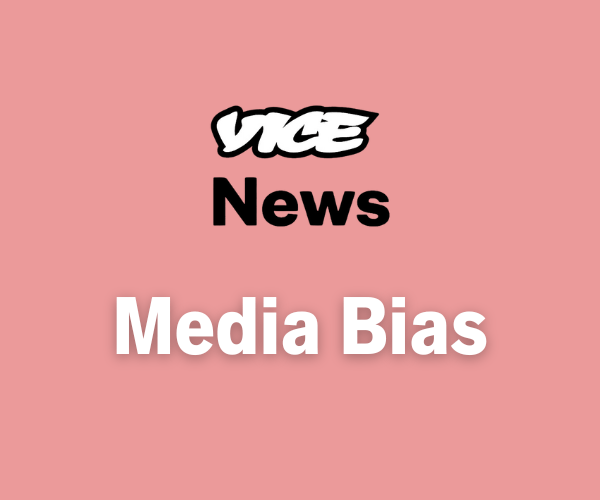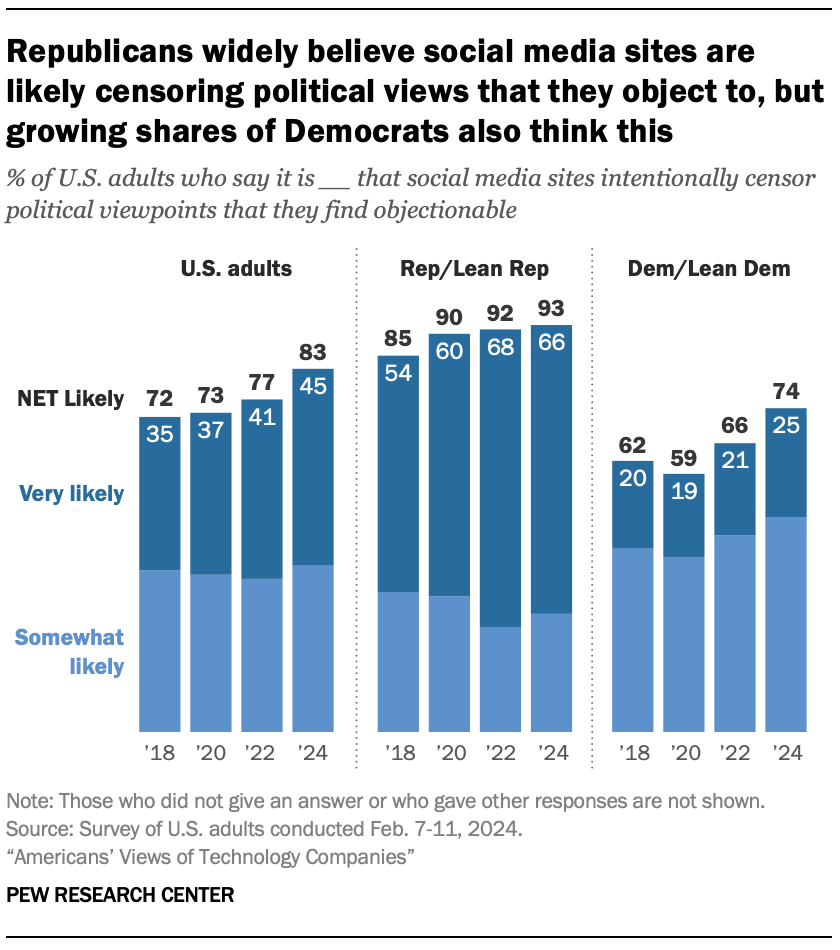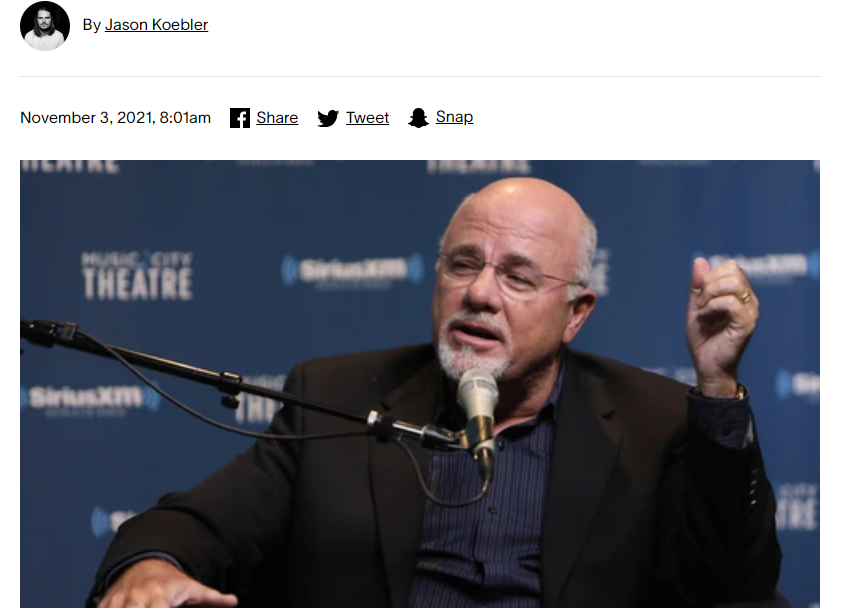
Vice News is an alternative journalism focusing on under-reported and investigative stories. Founded in 2013, they quickly gained popularity using various media platforms to publish daily stories and videos in addition to their more traditional publications on their website. Their marketing strategy took advantage of social media and its benefits in spreading information.
However, social media, including YouTube, Instagram, TikTok, and more are perceived as both biased and censored in the eyes of the public. While Pew Research found Republicans to be more likely to believe that censoring political views was prevalent, it has become a more common belief across party lines. 83% of U.S. adults believe that it is likely political censorship occurs on social media sites.

Source: Pew Research Center
With American concern for censorship, and in turn bias, on the rise, it has become more important to learn the political beliefs of each source of information we use. Vice’s tendency to use non-traditional outlets often lends readers to believe it is quite politically biased. However, reputation alone does not determine the bias of a publisher, but rather certain factors which we will discuss in this article. These factors provide a more definitive answer for Vice’s political leanings.
How Does Biasly Rate News Sources?
Biasly’s algorithms produce bias ratings to help provide multiple perspectives on given articles. Biasly has analyzed 200,000+ news articles from more than 3,200 news sources through our A.I. technology and team of political analysts to find the most factual, unbiased news stories.
Biasly determines the degree of political bias in news sources by using Biasly’s Bias Meter Rating, in which Biasly’s team analyzes media sources’ reliability and bias and produces three scores, a Reliability Score that measures the accuracy of media sources; an A.I. Bias Score, evaluated by A.I.; and an Analyst Bias Score evaluated by political analysts. These scores are rated based on seven rating metrics including Tone, Tendency, Diction, Author Check, Selection/Omission, Expediency Bias, and Accuracy. These metrics help our analysts to determine the political attitude of the article.
Our A.I. machine-learning system employs natural language processing and entity-specific sentiment analysis to examine individual articles and determine their bias levels. By analyzing the key terms in an article such as policies, bias phrases, political terminologies, politicians, and their nicknames, the algorithms can rate the attitude of the text. Bias scores range from -100% and 100%, with higher negative scores being more liberal and higher positive scores being more conservative, and 0% being neutral.
Is Vice Politically Biased?
Vice’s rating for its political bias is the result of two different forms of analysis by Biasly, AI, and its analysts. Biasly acknowledges the limitations of AI as well as the tendency for its analysts to have their own biases which impact the scores of each article. In the case of Vice, both its Analyst Score and its Computer AI Score are Very Liberal. The Analyst Score is the result of conservative, liberal, and center analysts individually rating 15 articles from the given source. Due to the nature of some articles being inherently more biased than others, the more articles reviewed result in a more accurate figure that will ultimately cancel out any outliers. Biasly agrees with other similar websites with Vice’s liberal leanings.
It is important to remember that bias is not only sourced from the articles and their authorship but also from the reader’s particular biases toward certain policies or political parties. For example, a conservative reader may discredit or avoid articles published by Vice News because of its liberal tendencies. This results in blind spots in areas of coverage that either political party may avoid because the stories do not align with their worldview. Recognizing personal bias is the first step in addressing facts against opinions in the media we consume daily.
Before we begin, we need to discuss bias. Bias is a natural function of humans, and we can express it both consciously and unconsciously. Bias is one of the most fundamental forms of pattern recognition in humans. This isn’t to lower the bar and say that “all things are biased,” but to explain the process in which we may come to trust certain news organizations that display patterns of coverage.
On the media’s part, there is an incentive to retain audiences, encourage them to purchase subscriptions, and rate products positively. Bias is a two-way street, people want to see news stories about things they care about, and the media needs viewers to continue their operations. This creates a positive feedback loop that influences what stories are covered and from what perspective. This also explains the actions of more liberal news organizations.
Analysis of Vice Online Articles
Bias is determined by 5 measurable and common metrics; Tone, Tendency, Author, Diction, and Expediency Bias. These metrics help our analysts avoid relying on their political leanings and instead hold them to a measurable standard of evidence when determining the political leanings of a given article. By extension, these metrics will also improve the media literacy of conscious readers to the bias of modern media. We elaborate on these metrics below:
- Tone: Tone refers to the culmination of the author’s bias demonstrated most frequently through their word choice and attitudes
- Tendency: The frequency at which political biases influence the given piece.
- Author: Previously documented biases of the author that may or may not be visible in the piece itself.
- Diction: The influence of the author’s use of language, in terms of bias, to sway the audience’s perception either positively or negatively toward a particular topic
- Expediency Bias: Images, headlines, and summaries that influence the immediate perception toward a given topic.
The following article “‘Everything That’s Going On’ Explains Everything That’s Going On”, written by Jason Koebler, is an excellent example of both Vice’s general biases and these metrics in action. Biasly’s AI rating of the article found it to be “Center”, while our analysts disagreed with a rating of “Medium Liberal.” The difference is interesting, hence the need to further analyze the metrics to determine the truth.
This article discusses the language use of Republicans, attempting to explain certain attitudes and phrases that were becoming more popular at the time of its publication. Consider the following headline and photo associated with the expediency bias of this piece:

Immediately, the bias of this article should be clear to readers. It appeals to left-wing audiences who have a negative impression of right-wing media and politicians. For neutral readers, it portrays the arguments and political language of Republicans as generalized and non-specific. The photo connects these thoughts with conservative media in particular, using an unflattering still of Dave Ramsy, a conservative who hosts a financial advice radio show.
In other words, it establishes the argument that conservative media is not addressing the issues it claims to as a premise to the logical structure of the article. Doing so immediately establishes a liberal bias. However, it is largely a factual headline. Its biases, while overt, reflect the article’s recognition of its liberal audience, attempting to explain some of the language of republican media to unfamiliar audiences.
The tone is similarly biased, while the AI may not recognize the sarcastic undertones of Koebler’s article, some audiences may recognize his jeers toward the right. For example:
“This is just to say that while Ramsey occasionally rails against Congress or Joe Biden or ‘socialism,’ it is not all he talks about, and most of his callers are just normal people calling in for normal advice”
“‘Everything That’s Going On’ might mean reckless government spending, vaccine mandates, government takeover, a rigged election, ‘critical race theory,’ ‘socialism,’ trans people being allowed to use the bathroom of the gender they identify with, having to wear a mask, or generally being asked to acknowledge that slavery happened, was bad, and has continued to shape the power dynamics of this country. Everything That’s Going On is a way to center yourself and your family as being directly aggrieved by minor inconveniences, policies designed to make others’ lives more tolerable, or completely imaginary things altogether.”
“One person might say they are mad about ‘everything that’s going on’ (having to get a vaccine to keep their job) and the person they’re saying it to might interpret that as ‘everything that’s going on’ (white people are being replaced by immigrants in a white genocide).”
These quotes each demonstrate a key difference between diction and tone. The author uses quotation marks to downplay the concerns and ideas of Conservative voices including socialism and critical race theory. Koebler never clarifies the critiques of these concepts from Conservatives, however, placing them in quotations compared to the other principles indicates that they are talking about a different socialism or different critical race theory than the rest of the country.
When describing other republican concerns in the second quote, their political concerns are written off as minor inconveniences or directly in opposition to the necessities of minority groups. While the list of issues is certainly important for republican groups, there tends to be greater nuance in their claims which aren’t addressed. Simply put, it is a liberal perspective regarding conservative talking points, openly disregarding the full picture in favor of a more biased perspective of said political stances. This continues throughout the article, indicating that consistent bias also has a greater tendency toward liberal bias.
The diction bias is considerably more neutral comparable to both tone and tendency. While the tone is laced with sarcasm, the word choice does not directly contribute to the bias. The best example of this is the following line from the previous citations:
“‘Everything That’s Going On’ might mean … generally being asked to acknowledge that slavery happened, was bad, and has continued to shape the power dynamics of this country.”
The word choice is not inherently biased, however, the concepts he is trying to argue create a picture that hyperbolizes conservative talking points and indicates negative or uncompassionate actions and beliefs associated with the right. This creates a tone that is objectively skewed to the left. In short, to determine a definitive rating of this particular bias, it leans slightly to the left.
The author’s, Jason Koebler, personal biases are difficult to assess from his public accounts. This is largely because his recent posts discuss the latest developments in technology and the discussion surrounding it, which hasn’t become a politicized enough subject to decipher conservative and liberal takes. However, his previous posts do demonstrate support of liberal policies, for example:
“Utah set up a complaint form to enforce its transphobic ‘Bathroom Bill’ and left the database connected to it open to the public, which shows that it has been used exclusively for memes and trolling”
Utah set up a complaint form to enforce its transphobic “Bathroom Bill” and left the database connected to it open to the public, which shows that it has been used exclusively for memes and trollinghttps://t.co/TCrXNnJhmG
— Jason Koebler (@jason_koebler) May 3, 2024
“The Russian government copy pasted Wikipedia to a new site, censored the articles, then banned the original Wikipedia. Head of new Russian government Wikipedia is the old admin of real Russian Wikipedia”
The Russian government copy pasted Wikipedia to a new site, censored the articles, then banned the original Wikipedia. Head of new Russian government Wikipedia is the old admin of real Russian Wikipediahttps://t.co/qxCtQg11p5
— Jason Koebler (@jason_koebler) April 29, 2024
“TikTok ban is deeply stupid, definitely unconstitutional, a complete failure of governance. Pathetic that it was attached to a must-pass bill”
TikTok ban is deeply stupid, definitely unconstitutional, a complete failure of governance. Pathetic that it was attached to a must-pass bill https://t.co/rFrIDVzBi4
— Jason Koebler (@jason_koebler) April 24, 2024
The tweets are not as biased as the phrasing in the article, however, some of his posts demonstrate reporting on stories with a left-wing bias. This includes the liberal perspective in reporting on topics such as the Utah transgender bathroom law. Others are more neutral, or not as partisan, including takes on TikTok and foreign affairs. In other words, Koebler seems to have more of a nuanced stance on a variety of issues, with a slight lean to the left.
Koebler, in this particular article, is openly writing with a liberal bias, as the article’s intended audience is those on the left who may be misinformed regarding conservative media talking points. However, because of the article’s bias against conservative views, the left appeal becomes demonstrable bias which paints right-wing media in a negative light instead of objective reporting. Audiences should keep in mind that bias varies from article to article, even in publishing sites that generally lean in a particular political direction. Each of these factors contributes to the ultimate bias of any given piece.
Analysis of Vice Opinion Articles
When determining bias in a news piece it is important to distinguish between an opinion piece and reporting. While reporting typically attempts to maintain objectivity in its analysis and presentation of facts, opinion pieces serve as a platform for writers to publish their perspectives regarding current issues. The subjective reporting, however, provides useful insight into the thoughts and arguments of those who have opposing views to the reader. Its usefulness, however, begins with the recognition and identification of bias.
Two opinion articles demonstrate the identifiable difference between reporting and opinion pieces from Vice. First, “Opinion: Pride Has Betrayed Us”, written by Diana Tourjee. This article primarily addresses liberal talking points regarding how to address the disconnect between the pride movement with trans women, particularly the disproportionate violence conducted against them.
It is important to note that both reporting pieces and opinion pieces use objective facts, just as Tourjee cites the homicide rate among transwomen comparable to the general population. The primary difference is her expressions of anger against the capitalization of pride events and the lack of significant progression made toward the cause.
While presenting objective facts, she presents these facts to make a case for the increasing pressure to promote left ideas regarding pride and all it entails. Simply reporting on a similar story would not pressure legislative or social change, rather, it would focus on the stories and perspectives regarding the apparent gap between the pride movement and current events.
The other article is completely non-political and quite humorous, titled “Opinion: Watermelons are Too Heavy” written by Jason Koebler. It is exactly as it sounds, Koebler describes his struggles with purchasing and transporting watermelon in New York without a vehicle. He even emails the Watermelon Board in regards to his dilemma, which results in this line:
“Thanks for thinking watermelon! [Editor’s Note: they signed off with a watermelon emoji that is breaking our site to include but please just envision a watermelon here]”
In addition to depicting his dilemma with watermelon transportation, he uses the opportunity to inform audiences of an outbreak of salmonella in precut watermelons. This is a classic opinion piece that demonstrates the structure of the genre; incorporating personal stories and using objective evidence to argue or discuss the personal views of the author.
Understanding the difference between subjective and objective pieces is key to unlocking a greater perspective on the general bias of consumed content. It is important to remember that one is not necessarily more important than the other, as they simply serve different purposes for different necessities in the current media landscape. An informed audience should begin by recognizing the inherent differences between an opinion piece and a report, as it dramatically changes what to expect from and how to consume the piece.
Who Owns Vice?
Vice was cofounded by Suroosh Alvi, Shane Smith, and Gavin McInnes, however, Bruce Dixon has been CEO of the company since February of 2023. While his time with Vice has been brief, his decisions have been of great consequence for Vice as they have navigated difficult financial circumstances. Directing them through bankruptcy and creating a strategy to move forward financially, his efforts have been critical in assisting them at this time. His online presence is notably abstinent from significant political biases.
How to Evaluate and Uncover Bias
It can often be difficult to tell if the news you watch is biased. If you have settled on a news channel, it’s usually because you trust the information you are gaining. Unfortunately, many trust the information they are hearing because it confirms what they already believe. This is referred to as “confirmation bias.” It is important to challenge your beliefs and get third-party verification that what you are hearing is the full story. This is why we recommend using Biasly to compare different news stories side-by-side using our bias ratings to figure out what both sides think of a political issue.
Regardless of Vice’s Medium Liberal score, audiences should maintain that each article and author will present unique perspectives, and with it unique biases. Some articles may be more liberal, conservative, or entirely apolitical. It all depends on the contributing factors and biases that determine its political alignment. Part of Biasly’s goal is to extend media literacy in a world that is growing increasingly divided. To assist readers who wish to better understand their own media consumption, Biasly has developed a Bias News Checker.






















